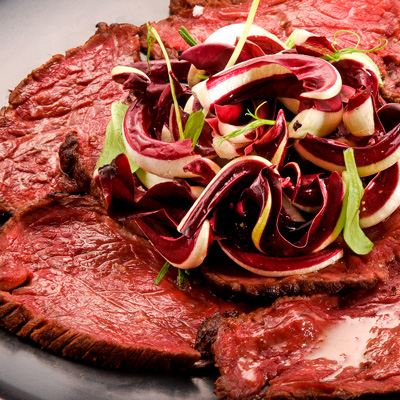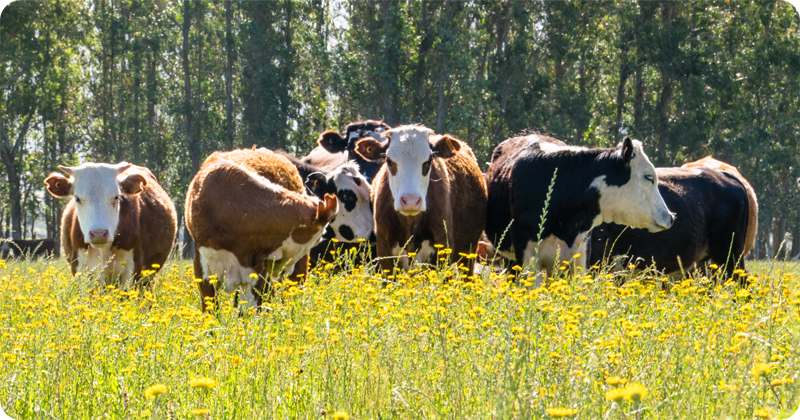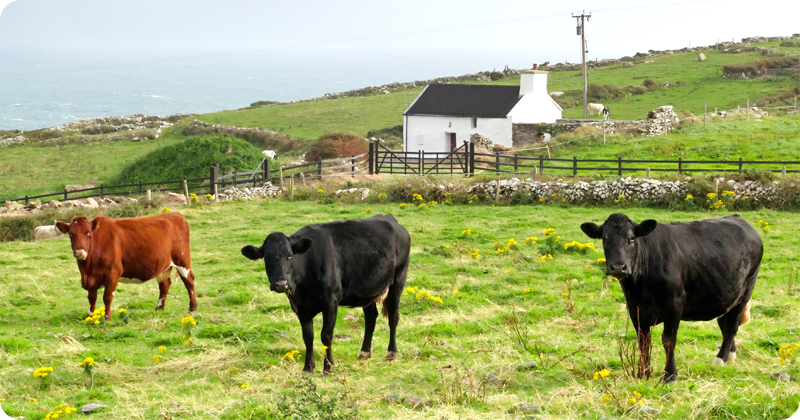
NEW ZEALAND

THE ORIGINS
New Zealand meat is internationally recognized for its high quality, tenderness and delicious taste. The animals grow in an exceptional environment: in the open air, on rich and abundant pastures, overlooking the Pacific Ocean and with a mild and constant climate all year round. They are also subject to constant, very strict quality controls. The result is a lean, nutritionally rich and high quality meat.
If you think of New Zealand cuisine, meat is the first thing that comes to your mind and, not by accident, it is the basic ingredient on the tables of this fascinating culture.
The passion for New Zealand culture and traditions, together with the excellent quality of its meat, are valid allies to get inspired and create new and original recipes.
If you think of New Zealand cuisine, meat is the first thing that comes to your mind and, not by accident, it is the basic ingredient on the tables of this fascinating culture.
The passion for New Zealand culture and traditions, together with the excellent quality of its meat, are valid allies to get inspired and create new and original recipes.
|
|
|||||||||||||||

ENTRECÔTE
Very fine cut made from New Zealand beef loin without bone. Thanks to the breeding in a natural way in an exceptional environment surrounded by the Pacific Ocean, the meat is particularly tender, tasty and with very little fat, it can be of different thickness and is good for many different preparations: grilled, baked or pan-fried. In France, the native land of this preparation, it is often accompanied by sauces of various kinds.
Preparation tips
Cooking mode Remove the packaging. Once the package is opened, it is recommended to oxygenate the product for at least 10 minutes so that it regains the typical colour of fresh meat.
Entrecôte with artichokes and potatoes
 Cook potato sticks and artichoke wedges in salted water and flavour them with thyme; halfway through cooking, drain and leave to cool. Finish cooking the vegetables by grilling the potatoes and stir-fry the artichokes in oil.
Cook potato sticks and artichoke wedges in salted water and flavour them with thyme; halfway through cooking, drain and leave to cool. Finish cooking the vegetables by grilling the potatoes and stir-fry the artichokes in oil.Cook the entrecote on the grill for 2 minutes. Prepare the dish alternating potatoes, artichokes and meat. Finish with rosemary as a garnish.
FILLET STEAK
By far, the softest and most valuable cut. From the lumbar area, the cut involves a muscle almost never trained by the animal, hence its unmistakable tenderness.
Very small in size, it is a single piece that can be divided into three parts, each perfect for different consumptions. It can be used for making steaks, tartare, carpaccio, chateaubriand, tournedos and filets mignon.
Very small in size, it is a single piece that can be divided into three parts, each perfect for different consumptions. It can be used for making steaks, tartare, carpaccio, chateaubriand, tournedos and filets mignon.
Preparation tips
Cooking mode Remove the packaging. Once the package is opened, it is recommended to oxygenate the product for at least 10 minutes so that it regains the typical colour of fresh meat.
Fillet with porcini mushrooms and truffle
 Cook sliced porcini mushrooms in a non-stick pan with garlic and oil for about 10 minutes. Season with salt and pepper, add parsley and a few flakes of truffle.
Tie the fillets with kitchen string and cook them 5 minutes on each side, over high heat. When cooked, garnish with grated truffle. Serve meat and mushrooms, finishing with truffle flakes.
Cook sliced porcini mushrooms in a non-stick pan with garlic and oil for about 10 minutes. Season with salt and pepper, add parsley and a few flakes of truffle.
Tie the fillets with kitchen string and cook them 5 minutes on each side, over high heat. When cooked, garnish with grated truffle. Serve meat and mushrooms, finishing with truffle flakes.


ROAST-BEEF
Top quality cut, thin and wrapped in a thin strip of fat. It includes all - or almost all - the dorsal area of the animal. If with the bone, it is called rib eye, while without the bone, it provides sirloin steak. Suitable for roasting and for the preparation of the typical English roast beef.
Preparation tips
Cooking mode Remove the packaging. Once the package is opened, it is recommended to oxygenate the product for at least 10 minutes so that it regains the typical colour of fresh meat.
Roast beef with orange
 Brown the roast beef on a high heat in a buttered casserole, sprinkle with the juice of 2 oranges and transfer it to a hot oven at 230°C. Cook for half an hour. In a saucepan, add white wine to the cooking juice; add a teaspoon of starch, half a glass of cream and an orange rind. Season with salt and bring to the boil.
Brown the roast beef on a high heat in a buttered casserole, sprinkle with the juice of 2 oranges and transfer it to a hot oven at 230°C. Cook for half an hour. In a saucepan, add white wine to the cooking juice; add a teaspoon of starch, half a glass of cream and an orange rind. Season with salt and bring to the boil.Slice the roast beef and serve it with the orange sauce separately.
RUMP
A cut of rather fine beef that joins the thigh and sirloin. Low fat, tender and moderately digestible, the rump is extremely versatile in the kitchen: ideal for grilling, in the pan or in the oven, it can also be transformed into quality ground meat. Less suitable for long cooking (boiled, braised and stewed).
Preparation tips
Cooking mode Remove the packaging. Once the package is opened, it is recommended to oxygenate the product for at least 10 minutes so that it regains the typical colour of fresh meat.
Rump slices with onion and red wine
 Brown a sliced white onion in a well oiled pan.
Brown a sliced white onion in a well oiled pan.Cut the edges of the rump slices and add them to the onions. Brown the meat on both sides, sprinkle with red wine and raise the heat to evaporate the alcohol. Turn steaks often.
Season with salt, continue cooking for 2 minutes and serve.


HAMBURGER
Famous dish of minced and pressed meat.
The different types of meat used must create a perfect mix between fat and firm meat in order to obtain the right balance between taste and juiciness.
It is mainly cooked in a frying pan or on the griddle and is eaten in a simple way or inside a sandwich with the addition of tomato, lettuce, cheese and sauces at will.
Preparation tips
Cooking mode Remove the packaging. Once the package is opened, it is recommended to oxygenate the product for at least 10 minutes so that it regains the typical colour of fresh meat.
Hamburgers with Brie
 Cook the hamburger on a hot griddle and roast some strips of peppers. When cooked, place the Brie cheese on the meat and wait for it to melt.
Toast the bread and stuff it with ketchup, lettuce, tomato, meat and brie, a few pepper strips and more tomato and lettuce.
Cook the hamburger on a hot griddle and roast some strips of peppers. When cooked, place the Brie cheese on the meat and wait for it to melt.
Toast the bread and stuff it with ketchup, lettuce, tomato, meat and brie, a few pepper strips and more tomato and lettuce.Close with the second slice of bread and serve with French fries.
ANGUS
Very tender, juicy and savoury, Angus meat is smooth, compact and with thin filaments of fat which, once dissolved in the cooking process, release an intense aroma and enhance its softness. Rich in precious nutrients, 100 grams of Angus provide only 124 kcal (82% protein and 18% fat). A delicious and genuine dish.
Simple cooking methods (pan, plate, grill) are the best way to enhance and appreciate the noble qualities of the product.
Simple cooking methods (pan, plate, grill) are the best way to enhance and appreciate the noble qualities of the product.
Preparation tips
Cooking mode Remove the packaging. Once the package is opened, it is recommended to oxygenate the product for at least 10 minutes so that it regains the typical colour of fresh meat.
Angus with radicchio
 Prepare a sauce with oil, thyme, rosemary, marjoram, sage, basil and mint. Brush the angus threads on both sides and also the plate. Halfway through the cooking process of the meat, add a head of red radicchio divided into 4 slices on the plate.
Prepare a sauce with oil, thyme, rosemary, marjoram, sage, basil and mint. Brush the angus threads on both sides and also the plate. Halfway through the cooking process of the meat, add a head of red radicchio divided into 4 slices on the plate.To obtain an even tastier meat, continue to add the sauce as the cooking progresses (10/15 minutes for rare cooking). Serve by placing the angus on the bed of radicchio.

 ARGENTINA
ARGENTINAArgentina produces some of the best meats in the world for taste and tenderness. The goodness and
peculiarities of Argentine meat can be traced back to the completely natural method with which the beef is reared. Left to
live in the wild in the endless pampas, the animals feed exclusively on grass. This type of farming favours the production
in the animal of substancesthat contribute to making the meat soft, tasty and healthy.
 URUGUAY
URUGUAYUruguay produces a meat that, among other countries in South America, is distinguished by quality.
The excellence of the product is based on the type of farming. The animals, in fact, live in the open air in total harmony
with the environment. The result is a meat with a refined taste, high nutritional value, guarantee of origin and
authenticity. Uruguayan meat is rich in Omega 3, Vitamin E (antioxidants) and has low fat levels.
 BRAZIL
BRAZILBrazil, the world leading beef exporter, is increasingly highlighted by the quality of its meat. A
tender and tasty meat obtained through production systems in temperate, tropical pastures and intensive systems that
produce the most distinct quality specifications.
The healthy and natural diet of the animals guarantees the authenticity and safety of the meat and the preservation of the environment.
 USA
USAAmerican meat is famous for its high level of marbling, i.e. the uniform spread of fat. This
particular characteristic makes the meat soft, juicy and with a strong and tasty taste.
Cattle are reared in a totally natural way and fed on a maize-based vegetarian diet without the use of supplementary hormones, growth promoters or additives.
Cattle are reared in a totally natural way and fed on a maize-based vegetarian diet without the use of supplementary hormones, growth promoters or additives.
 AUSTRALIA
AUSTRALIAAustralia is known throughout the world to export high quality beef: very aromatic, tasty and with
a well-defined fat part. Tender and juicy thanks to the thin fibres and a high level of marbling. The cattle are reared
with a production system that is based on natural foods such as grass from pastures. The most prized and renowned
Australian meats are Black Angus and the highly prized Wagyu.
 PARAGUAY
PARAGUAYParaguay is one of the world leading beef exporters.
The excellence of Paraguayan meat is based on the type of farming. The animals, in fact, live in the open air in total harmony with the environment.
The meat is known for its marbled appearance, excellent tenderness and flavour characteristics, unbeatable taste and quality.
The excellence of Paraguayan meat is based on the type of farming. The animals, in fact, live in the open air in total harmony with the environment.
The meat is known for its marbled appearance, excellent tenderness and flavour characteristics, unbeatable taste and quality.
 CANADA
CANADACanada, one of the world's leading beef producers, selects the best breeds and raises them in a
pristine natural environment to provide the market with healthy, high-quality beef.
Canada's cool climate is an optimal habitat for animals. Canadian meat is known for its marbled appearance, excellent tenderness and flavour characteristics, unbeatable taste and quality.
Canada's cool climate is an optimal habitat for animals. Canadian meat is known for its marbled appearance, excellent tenderness and flavour characteristics, unbeatable taste and quality.
 JAPAN
JAPANKobe beef is a Japanese delicacy obtained from wagyu, a black mantle cattle of the Tajima breed.
Kobe meat is tender, very tasty and has an excellent taste. The merit lies in the marbling of the meat, which has a high
percentage of fat distributed evenly.
The registered trademark and the strict parameters imposed to define "Kobe's" meat, have made it a precious niche product,
renowned, expensive and sought after throughout the world.









